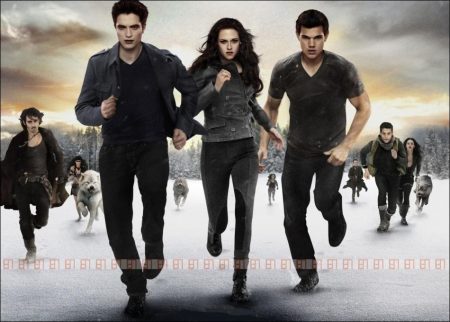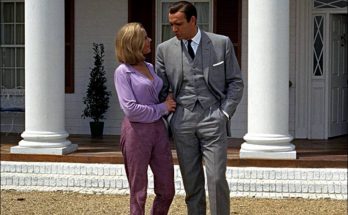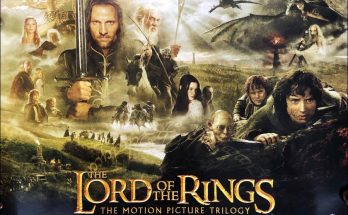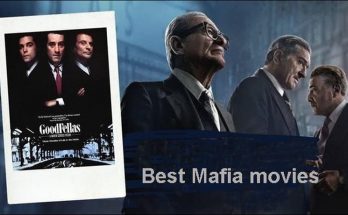One Production, Two Movies
The Twilight Saga Breaking Dawn Part 2 Shootings. A multi-national crew created Forks, Washington primarily in two major locations: in and around Baton Rouge and New Orleans, Louisiana, USA, as well as in Vancouver and Squamish, British Columbia, Canada. Shooting both movies at one time posed challenges, but shooting the series finale battle, was a battle on its own. “There’s heavier peril involved as the Volturi start to gather momentum and move from Italy to Forks. That build up is going to generate a lot of excitement leading up to the confrontation,” says co-producer Bill Bannerman.
Approaching the project as a whole, filmmakers had 20 weeks of prep time, about five months to find locations, build sets, create props, find set dressing, and prepare costumes, wigs, makeup, and hand painted contact lens for the largest cast of the saga for both films. Veterans Bannerman and first assistant director Justin Muller had to organize shooting to accommodate multiple actors’ commitments to publicity opportunities and other projects. “I thought Dreamgirls was a marathon with about a three month shooting schedule, so doing this 222 page script for over half a year – at the beginning did seem a little overwhelming,” reveals Condon.
Condon was thrilled to have the technical brilliance, as well as the heart and soul, of celebrated director of photography Guillermo Navarro with him for both the epic and intimate moments of the cinematic journey. “When I had my first meeting with Guillermo, at least on my side, it was instant love. He’s just an incredibly compelling personality and a great artist. His description of what he wanted to achieve was interesting right from the start,” says Condon. “Guillermo’s also got a great eye and a great sense of how to use the camera to get inside what a character is feeling, which was crucial.”
Taking their cues from the descriptions in Meyer’s book, production designer Richard Sherman and costume designer Michael Wilkinson were key collaborators in helping director Bill Condon conceive the look of the film. “Richard is somebody I have worked with since I started making movies. He seemed really right for this because of his fascination with all things Gothic, and especially vampires,” comments Condon.
“The great thing about Bill is that he knows exactly what he wants, but he’s malleable,” comments production designer Richard Sherman. “If you go to him with a great idea and he likes it, he’ll go with it. He’s not stubborn. He trusts his crew, which is very, very important. I always have fun with him.”
“What really attracted me to this film primarily was this wonderful, dramatic sense of transformation and empowerment for Bella, which must be reflected in her clothes,” says costume designer Michael Wilkinson. “Her journey in these two films is really breathtaking. She starts as a young woman in a small town, and end as the most powerful vampire in the world. In the two films, Bella has about 60 costume changes.”
“Michael has that perfect combination of talents,” continues Condon. “He is a great comfort to me, having worked on big design movies – fantasies like 300 and Tron: Legacy – that feature huge casts of distinct characters. But also, he’s done realistic movies, and he really knew how to dress Bella.
In these movies, we are taking these kids and bringing them into adult life. Kristen starts in a hoodie, but she becomes a young married woman, who then becomes a strong vampire. I thought Michael has a real sensitivity to how to visually take these characters into their 20s. In this second movie, all these characters from across the globe – Amazon, Russia, Egypt, and everywhere – all gather at one point, and you have to make them make sense together in a frame, and Michael was really brilliant at that.”
“It was really important for Bill and I that there was a sense of believable to all of them, and yet at the same time they had to be very striking, appealing, memorable, and iconic in the look of these covens and individuals. For each nationality, we tried to really give them a very well defined flavo,” Wilkinson comments.
Godfrey adds, “Michael has a great mix between the real and the fantasy – look at his work in Watchmen – and given that we’re finally getting out of the human world of Forks and creating all of these new vampire characters, it needed to be pushed into a bigger reality.” “Like for the battle in Eclipse, we had wilderness venue with two opposing sides and two units gathering footage,” says Bannerman. “On Eclipse, we had 13 days between the two units with the Cullens, newborns, and wolves.
Fast forward to Breaking Dawn, we now have 30 days between the two units, but we need to cover about 30 pages of dialogue and subsequent action with the Cullen Coven, the Cullen allies, the wolves, the Volturi, the Volturi Guard, and the Volturi witnesses. The number of people involved on screen actually tripled and the CG wolves has doubled to 16. Everything is ramped up tenfold. You’re talking at least a bare minimum of six to seven weeks of shooting in Baton Rouge alone, just for the battle.”
The exteriors of the penultimate battle would be shot in wilderness areas in Canada, but for the intense dialogue and intricate stunt work between many actors, filmmakers needed a more practical private space, secure from fans and paparazzi. “Where are we going to shoot all this efficiently, controlling as many variables – including weather – as we can? We had no choice but to choose a pragmatic location, instead of dealing with trying to transport more than 500 people and everything up mountainous terrain,” reasons Bannerman.
To handle all the requirements, filmmakers selected the Southern University Agriculture Center Livestock Arena to be the home of the battle. “We were outside of Baton Rouge in a giant space where normally cows are running around, but now there are humans,” laughs Godfrey. “We’ve created a virtual space of a snow-covered field. It’s the culmination of five films, where the chess game with Aro comes to a head and the fight breaks out.”
“Shooting there turned out to be the most grueling part of the shoot for everybody involved, especially the actors. But we always kept reminding ourselves, that bad as it was, it could’ve been so much worse if we’d been outside in the real snow for months,” laughs Condon. Condon adds, “We got into the scene very early in the shoot, before Christmas of 2010, and it was odd because the scene wouldn’t actually be in theaters until almost two years later. We had limited shooting time, and it was such a big scene, that we had stage it like a play first. We took an entire day just to block the scene, playing it through beat by beat by beat with the actors. That rehearsal turned out to be invaluable, because so much of it was abstract. I’ve never been involved with anything that was so logistically complicated.”
Complicated stunts played out in the space. “Jeff Imada is the fight coordinator that we brought to Louisiana for the battle,” states Godfrey. “He’s incredibly well experienced, having done the Bourne movies. He is also very disciplined and very good with the actors. His work elevates the action from the previous films.”
Battling vampires have more strength and speed than humans. “A lot of times we decide what’s adequate for flying the actors, what looks natural to the body, the body mechanics and what you’re trying to achieve,” explains Imada. “When it’s bigger than life, many times you go to pneumatics and bring in ratchets. But if you want a more natural look, covering a long distance, then we would use the winches.”
Right before the action explodes, Alice arrives on the field to show Aro his destiny. “Alice comes backs to really kick butt,” says Ashley Greene. “Because she can see the future, she has an advantage. We had a really fun time creating the fight sequence; Alice is dangerous and ferocious inside the vision, where some of my family members are lost, including Jasper. Alice goes a little crazy. I definitely commit. I like to be able to do my own stunts. If I know there’s a stunt sequence, I’m the gym training and working with stunt trainers to make sure I’m up to the task. I have a martial arts background, so whatever they’ll let me do, I’ll do.”
Her on-screen mate Jackson Rathbone also enjoyed the stunts. “I never really imagined myself to be an action guy, but man I love it,” he says. “I have a history in Taekwondo, and now I get to learn a little Kung Fu and fighting for camera. It’s going to be really exciting on screen and I get to work very closely with Jeff Imada and his crew. It’s so much fun as the stunt guys and women are just the salt of the earth. They’re incredible performers so to have them train me is just great. A lot of us worked six days a week, rolling back and forth between main unit and second unit, so that’s a lot of fighting.”
Views: 104



